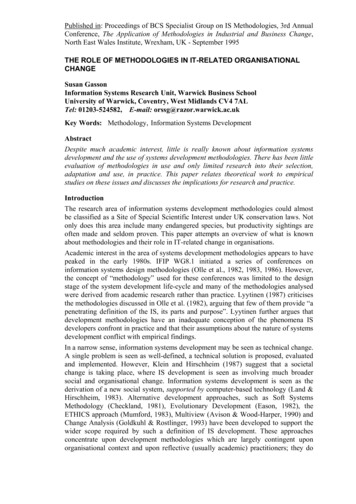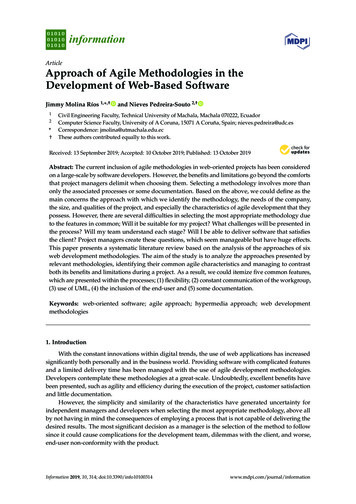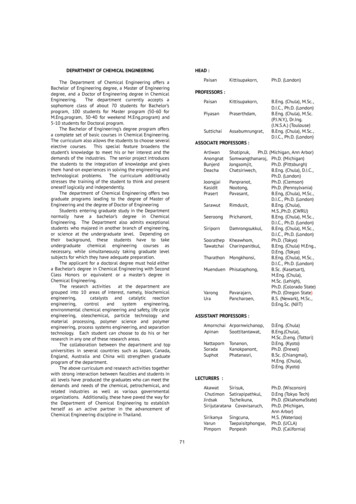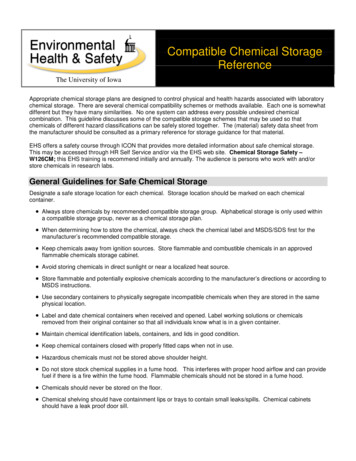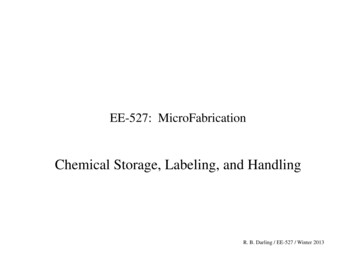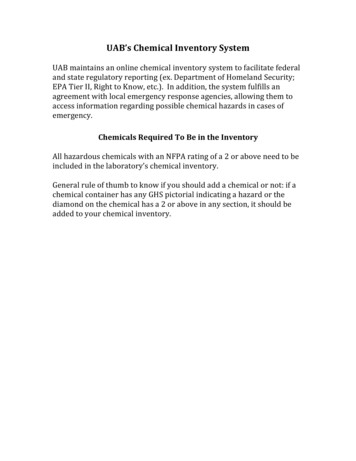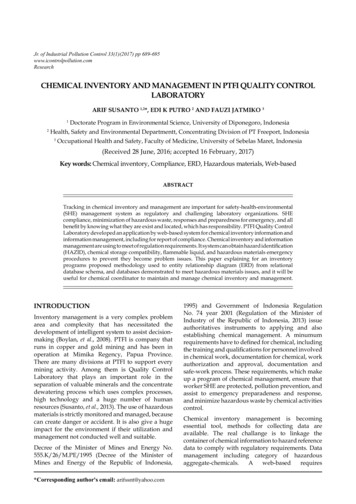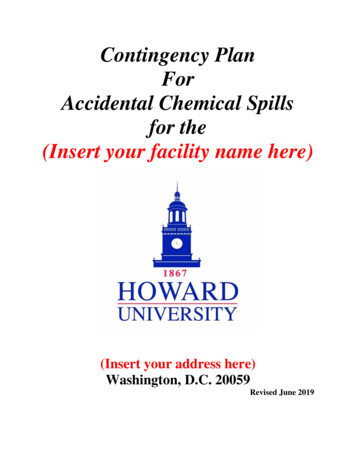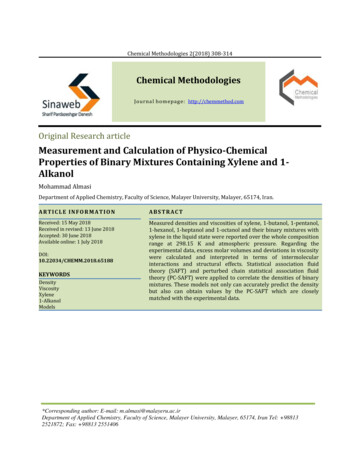
Transcription
Chemical Methodologies 2(2018) 308-314Chemical MethodologiesJournal homepage: http://chemmethod.comOriginal Research articleMeasurement and Calculation of Physico-ChemicalProperties of Binary Mixtures Containing Xylene and 1AlkanolMohammad AlmasiDepartment of Applied Chemistry, Faculty of Science, Malayer University, Malayer, 65174, Iran.ARTICLE INFORMATIONABSTRACTReceived: 15 May 2018Received in revised: 13 June 2018Accepted: 30 June 2018Available online: 1 July 2018Measured densities and viscosities of xylene, 1-butanol, 1-pentanol,1-hexanol, 1-heptanol and 1-octanol and their binary mixtures withxylene in the liquid state were reported over the whole compositionrange at 298.15 K and atmospheric pressure. Regarding theexperimental data, excess molar volumes and deviations in viscositywere calculated and interpreted in terms of intermolecularinteractions and structural effects. Statistical association fluidtheory (SAFT) and perturbed chain statistical association fluidtheory (PC-SAFT) were applied to correlate the densities of binarymixtures. These models not only can accurately predict the densitybut also can obtain values by the PC-SAFT which are closelymatched with the experimental iscosityXylene1-AlkanolModels*Corresponding author: E-mail: m.almasi@malayeru.ac.irDepartment of Applied Chemistry, Faculty of Science, Malayer University, Malayer, 65174, Iran Tel: 988132521872; Fax: 98813 2551406
Measurement and Calculation of P a g e 309Graphical AbstractIntroductionThe densities and excess molar volumes of the investigated liquids and their mixtures are required,for instance, for relating excess enthalpy and excess Gibbs free energy values. From a practicalpoint of view, the data are useful for the design of mixing, storage, and process equipment. Ourstudies are directed to investigate non-aqueous binary mixtures by physico-chemical properties [14] to provide useful informations about the molecular interactions. The density, viscosity andrelated properties of the xylene and 1-alkanol binary systems are reported here. Because of thepresence of active sites for molecular interactions in both components, it is expected that themacroscopic behaviour of their binary mixtures may be related to these molecular features andinteraction network. Therefore, this study aims to understand the intermolecular interactionsbetween the xylene and 1-alkanol with differing hydrocarbon chain length. In recent years, thedevelopment and application of predictive models over a wide temperature range are extended.Recently, Gross and Sadowski have developed a new variation of the statistical association fluid(SAFT) theory called PC-SAFT. At present time, PC-SAFT is the most used version of the SAFT EOS.The correlative abilities of the SAFT and PC-SAFT models were tested in order to calculate thedensities of binary mixtures.
Mohammad AlmasiP a g e 310ExperimentalThe used xylene, 1-butanol, 1-pentanol, 1-hexanol, 1-heptanol and 1-octanol were purchased fromMerck and were used without further purifications. The mass fraction purities for all materials aregreater than 99%. Density and viscosity were measured with a totally automated SVM 3000 AntonPaar Stabinger viscometer that operates based on a modified Couette principle with a rapidlyrotating outer tube and an inner measuring bob which rotates more slowly. A set of tencompositions was prepared for each mixture and their physical properties were measured atvarious compositions in the mole fraction range. The expanded uncertainty is 1 10 –3 g·cm-3 fordensity measurements and the relative expanded uncertainty for viscosity measurements is 0.02.The estimated uncertainty in the mole fraction was 1 10 3.Results and discussionDensities and excess molar volumesDensities and viscosities for pure compounds and their binary mixtures at various temperaturesEare reported in Table 2. The excess molar volumes, V m were calculated usingN 1 1EV m xi M i( i )(1)i 1where xi is the mole fraction, Mi is the molar mass of component i, is the density of the mixture, i is the density of pure component i, and N stands for the number of components in the mixture.Figure 1 illustrates the graphs of excess molar volumes of xylene 1-alkanol mixtures at T 298.15K. As this Figure shows, the excess molar volumes for all binary mixtures are positive in the wholecomposition range. Generally,EVmcan be considered as arising from three types of interactionsbetween component molecules. Physical interactions mainly consist of dispersion forces or weakdipole-dipole interactions and making a positive contribution. Chemical or specific interactionswhich include charge transfer, formation of hydrogen bonds and other complex forminginteractions result in negative contribution. The positive deviation ofVmEfor xylene (1) 1-alkanol(2) solvent system is governed by steric hindrances of molecules which overcome the other effectdue to specific interactions between different species. In all the systems, the excess molar volumevalues are obviously increased with increasing the chain length of 2-alkanol. When the number ofcarbon atoms in the hydrocarbon part of 1-alkanol increases, the polar characteristics start
Measurement and Calculation of P a g e 311reducing which resist the formation of intermolecular interactions between xylene and 1-alkanoland hence the tendency to form associated complex decreases with the lengthening of carbon chain.Dynamic ViscositiesThe viscosity deviation can be calculated as x1 1 x 2 2where is the mixture viscosity,(2) 1 and 2 are the viscosities of pure components. Values ofviscosity deviations were correlated by the Redlich– Kister equation. Figure 2 indicates theviscosity deviations for binary mixtures xylene 1-alkanol at T 298.15 K. This figure shows thatthe viscosity deviations are negative for all binary mixtures over the entire mole fraction range andbecome more negative with increasing chain length of the alcohols.SAFT ModelIn this model, [5, 6] assumed that the liquid consists of equal-sized hard spheres, then, in order toaccount the attraction between the spheres, a dispersive potential is added. Next, to form thechains, two (or more) ‘sticky’ spots are given to the spheres. In the last step, at the certain positionof chain, specific interaction sites are considered. Existence of these sites will enable the chains toassociate through the attractive interaction like hydrogen bonding.PC-SAFT ModelIn the PC-SAFT model [7,8], a general expression for the residual Helmholtz energy is given byares ahc adis a assoc(3)a hc is the hard-sphere chain contribution, a dis is dispersion interactions contribution and a assoc isthe association effects. Details of SAFT and PC-SAFT equations are mentioned elsewhere and arenot provided here.SAFT and PC-SAFT models were used to correlate the density values. Table 2 lists the correlationparameters for binary mixtures evaluated by application of mentioned models. Two models yieldedsmall AAD and provided good correlations. By contrast, the PC-SAFT model provides more accuratevalues for densities and more agreement with experimental data.
Mohammad AlmasiP a g e 312Table 1. Densities ñ and viscosities η for the binary mixtures at 298.15 and pressure P 0.1 MPa.T/K 298.15Densities( /g·cm–3 ) for Xylene .00.80350.80380.80530.8053Viscosities (η 30.8030.5.050.03110.55880.53500.5330.533Table 2. Binary Interaction Parameter kij and standard deviationBinary SystemsXylene 1-ButanolXylene 1-PentanolXylene 1-HexanolXylene 1-HeptanolXylene 0.0180.0230.0280.032 3.10381.08031.3531.03130.00800.50.10.533for SAFT and PC-SAFT EquationskijSAFT1.321.231.431.561.73% PC-SAFT1.081.061.141.181.15
Measurement and Calculation of Figure 1. Excess molar volumesP a g e 313EV m vs. mole fraction of xylene for binary mixtures of xylene with ( ) 1-butanol, ( )1-pentanol, ( )1-hexanol, ( )1-heptanol, ( ) 1-octanol, 2-pentanol at T 298.15 K.Figure 2. Viscosity deviations η vs. mole fraction of xylene for binary mixtures of xylene with ( ) 1-butanol, ( )1-pentanol, ( )1-hexanol, ( )1-heptanol, ( ) 1-octanol, 2-pentanol at T 298.15 K.ConclusionDensities and viscosities for binary mixtures consisting xylene 2-alkanol were measured and thecorresponding excess molar volumes and viscosity deviations have been calculated. Excess molarvolumes are positive and viscosity deviations are negative for all the studied mixtures. Thestructure of xylene /alcohol mixtures is governed by hindrances effects in the carbon chain of
Mohammad AlmasiP a g e 314alcohols. Two models namely SAFT and PC-SAFT were applied to correlate the densities of binaryliquid mixtures and, as a result, they yielded low AAD for correlation of density. However, thepredicted values by PC-SAFT are more accurate.References[1] Iloukhani H, Almasi M. J. Solution. Chem., 2011, 40:284[2] Moftakhar M., Almasi M. J. Chem. Thermodyn., 2017, 113:315[3] Almasi M. J. Chem. Eng. Data., 2015, 60:714[4] Almasi M., Thermochim. Acta, 2014, 591:75[5] Huang S.H., Radosz M. Ind. Eng. Chem. Res., 1993, 32:762[6] Huang S.H., Radosz M. Ind. Eng. Chem. Res., 1990, 29:2284[7] Gross J., Sadowski G. Ind. Eng. Chem. Res., 2001, 40:1244[8] Gross J., Sadowski G. Ind. Eng. Chem. Res., 2002, 41:5510How to cite this manuscript: Mohammad Almasi. Measurement and calculation of physicochemical properties of binary mixtures containing Xylene and 1-Alkanol. Chemical Methodologies3(4), 2018, 308-314. DOI: 10.22631/chemm.2018.131939.1056.
Paar Stabinger viscometer that operates based on a modified Couette principle with a rapidly rotating outer tube and an inner measuring bob which rotates more slowly. A set of ten compositions was prepared for each mixture and their physical properties were measured at various compositions in the mole fraction range. .
